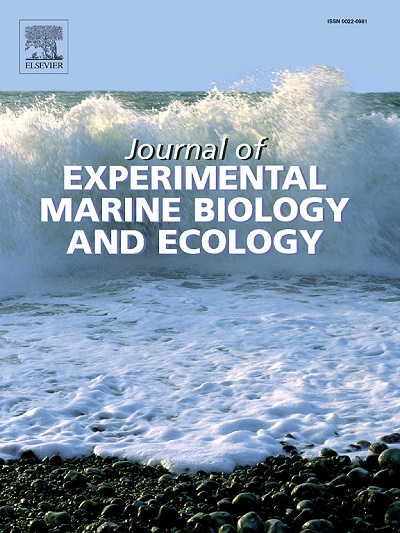Major and trace nutrient concentrations in sub-Antarctic forage fish around the Kerguelen Islands: All are not equal for nutrient recycling by top predators
IF 1.8
3区 生物学
Q3 ECOLOGY
Journal of Experimental Marine Biology and Ecology
Pub Date : 2025-03-24
DOI:10.1016/j.jembe.2025.152097
引用次数: 0
Abstract
While the nutrient content of forage species is crucial to study how marine top predators release nutrients in their waste (faeces and urine) and possibly facilitate nutrient recycling at lower trophic levels of the food webs, it is poorly documented in many ecosystems. Here, we analyse the concentrations of five major nutrients, eight essential trace nutrients, and four non-essential nutrients in 34 mesopelagic and demersal forage fish species from the Kerguelen Plateau area (Southern Indian Ocean). This biogeochemically singular region benefits from natural iron (Fe) fertilisation and is an oasis for marine life in the high nutrient low chlorophyll Southern Ocean. Its nutrient dynamics have been subject to intense research for decades, but the contribution of the biota remain unexplored. Local forage fish were found to be significantly heterogeneous in their absolute nutrient concentrations, and in their relative nutrient content. Using hierarchical clustering, we showed that some species were enriched in nutrients found in limited concentrations in Southern Ocean surface waters, such as Fe and manganese (Mn), whereas others were enriched in nutrients likely limiting primary productivity in terrestrial ecosystems, such as phosphorus (P) or calcium (Ca). These fish species could be major contributors to these nutrients' biological cycling in different ecosystems when consumed by predators. This functional typology further demonstrates that prey are not interchangeable. The consumption of one or another prey species modulates not only the ability of the predator to meet its requirements and exposure to contaminants, but also predator-mediated nutrient recycling. This work provides valuable baseline knowledge that can be used in studies of nutrition, nutrient dynamics, and contaminant transfer. It also paves the way for the inclusion of predator-prey relationships in local biogeochemical studies to help unravel the complex processes at work in this unique ecosystem.
凯尔盖伦群岛周围亚南极觅食鱼的主要和微量营养物质浓度:所有的营养物质在顶级捕食者的营养循环中都是不一样的
虽然饲料物种的营养成分对于研究海洋顶级捕食者如何释放废物(粪便和尿液)中的营养物质以及可能促进食物网中较低营养水平的营养物质循环至关重要,但在许多生态系统中,这方面的记录很少。本文分析了来自南印度洋克尔格伦高原地区34种中底栖饲料鱼的5种主要营养素、8种必需微量营养素和4种非必需营养素的浓度。这个独特的生物地球化学区域得益于天然的铁(Fe)肥料,是南大洋高营养低叶绿素海洋生物的绿洲。几十年来,它的营养动态一直是研究的重点,但生物群的贡献仍未被探索。本地饲料鱼的绝对营养浓度和相对营养含量具有显著的异质性。通过分层聚类,我们发现一些物种富含在南大洋表层水中发现的有限浓度的营养物质,如铁和锰(Mn),而另一些物种则富含可能限制陆地生态系统初级生产力的营养物质,如磷(P)或钙(Ca)。当这些鱼类被捕食者吃掉时,它们可能是不同生态系统中这些营养物质生物循环的主要贡献者。这种功能性类型学进一步证明了猎物是不可互换的。一种或另一种猎物的消耗不仅调节捕食者满足其需求和暴露于污染物的能力,而且还调节捕食者介导的营养循环。这项工作提供了宝贵的基础知识,可用于营养学,营养动力学和污染物转移的研究。它还为将捕食者-猎物关系纳入当地生物地球化学研究铺平了道路,以帮助解开这个独特生态系统中起作用的复杂过程。
本文章由计算机程序翻译,如有差异,请以英文原文为准。
求助全文
约1分钟内获得全文
求助全文
来源期刊
CiteScore
4.30
自引率
0.00%
发文量
98
审稿时长
14 weeks
期刊介绍:
The Journal of Experimental Marine Biology and Ecology provides a forum for experimental ecological research on marine organisms in relation to their environment. Topic areas include studies that focus on biochemistry, physiology, behavior, genetics, and ecological theory. The main emphasis of the Journal lies in hypothesis driven experimental work, both from the laboratory and the field. Natural experiments or descriptive studies that elucidate fundamental ecological processes are welcome. Submissions should have a broad ecological framework beyond the specific study organism or geographic region.
Short communications that highlight emerging issues and exciting discoveries within five printed pages will receive a rapid turnaround. Papers describing important new analytical, computational, experimental and theoretical techniques and methods are encouraged and will be highlighted as Methodological Advances. We welcome proposals for Review Papers synthesizing a specific field within marine ecology. Finally, the journal aims to publish Special Issues at regular intervals synthesizing a particular field of marine science. All printed papers undergo a peer review process before being accepted and will receive a first decision within three months.

 求助内容:
求助内容: 应助结果提醒方式:
应助结果提醒方式:


